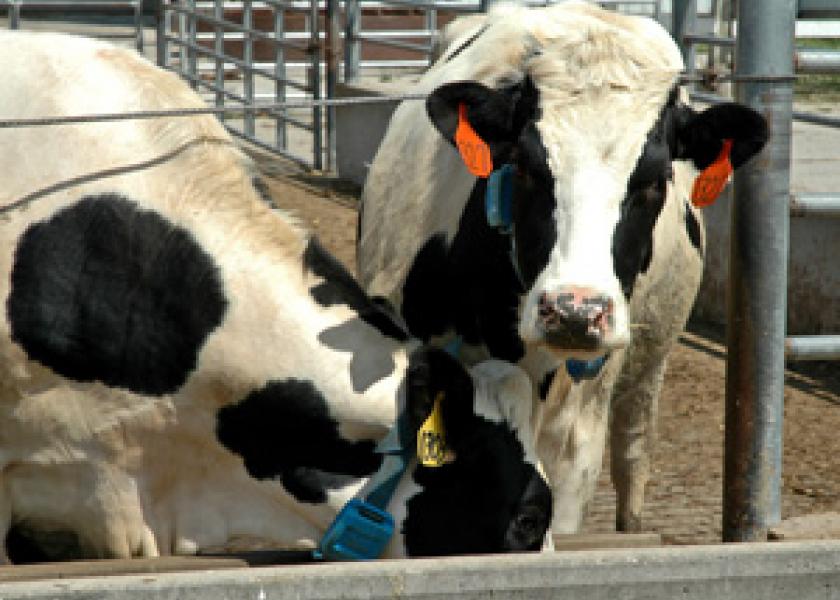Heat Detection Made Easy

Activity monitors, pedometers simplify heat detection
Forget tail chalk. Scribbled notes on your hand. Ovsynching each and every blessed cow. A new generation of activity monitors and pedometers is making heat detection a whole lot easier.
Ask Minnesota producer Paul Gjerde. Last Thanksgiving week, Gjerde ran 30 yearling heifers into his headlocks and strapped Select Detect activity monitors on their necks. "Within two weeks, all of them were detected in heat and bred," says Gjerde, who with his brother Kraig milks 300 cows near Sunburg, Minn.
Gjerde started using the monitors in April 2011. But already, he’s sold on the system. "We’ve saved thousands of dollars in synchronization drugs already. We estimate we’ll have the system paid for in 22 months," he says.
The activity monitors won’t totally eliminate synchronization programs on farms, acknowledges Casey Anderson, reproductive business manager for Select Sires, which markets the monitors. "But using the systems will identify cows that need to be synchronized," he says.
That percentage varies from farm to farm, with the average typically 15% to 20%, Anderson says. On Gjerde’s dairy, it’s less than 10%.
Gjerde places collars on fresh cows 30 to 40 days after calving. "By 45 to 50 days after calving, we’ll start to see activity spikes," he says.
Gjerde has a 58-day voluntary waiting period. If the pedometers pick up no activity by 78 days in milk, he will start the cow on an Ovsynch program to jump-start her ovaries.
With the system, Gjerde’s annualpregnancy rate is 18% to 20%. Before, using a full synchronization program, it had been running 22%. But the summer of 2011 was a brutal breeding season, and the herd’s pregnancy rate has since rebounded.
An automated heat detection program from Afimilk has been used by Jason Bradford of Sparta, Mich., for 10 years. He has not done any visual heat detection in that time, and his pregnancy rate is 24% on 1,300 cows.
"In summer, our pregnancy rate might dip to 18% or 20%. But we’ve also been as high as 29%," he says.
Bradford uses a sort gate to separate cows in heat after milking. Though he milks 3X, he inseminates mornings and evenings.
Bradford leaves the activity monitors on cows throughout lactation. The Afimilk monitors, which are now about $60 each, provide cow identification and alert him when activity drops below baseline as well.
"If her activity is down and she is off on milk, that usually means the cow is sick or lame," he says. "This system allows one person to do a lot of management without leaving the office."
Bradford believes the key to a good reproduction program is cow health following calving. "We focus on postpartum health and make sure the cow is eating well, has normal temperature and has a clean reproductive tract before she goes into our breeding pen," he says.
Bradford has been so successful with the approach that he does not use a synchronization program. That’s not to say he has no problem breeders. But they are few.
"When we do our vet checks and have a problem breeder, we will treat her for that problem—most often a cystic ovary," he says.
Limited Research
University research on automated heat detection is limited. One large, 1,000-cow study is under way in Wisconsin. A three-herd trial, involving some 900 cows, is slated to begin in late spring in Kentucky.
A smaller trial has been completed by Paul Fricke, a University of Wisconsin reproductive specialist. He and his team synchronized 112 cows in a commercial herd to come into estrus, and then used K-Mar patches and activity monitors to detect heats.
Sixty-eight percent of the cows ovulated and showed heat with the patches and activity monitors. Ten percent of the cows showed no heat, yet still ovulated based on ultrasound. Twenty percent showed no heat and no ovulation, and 2% showed heat but no ovulation.
"Failure to find cows in heat by activity monitoring is not an activity monitoring system problem," Fricke says. "The problem is that we still have a chunk of cows not following the reproduction textbook, and they’re failing to ovulate or show estrus when they should."
"These activity monitoring systems do an excellent job of determining when to inseminate cows that are showing heat and ovulating. But if you’re trying to get 100% heat detection with these systems, one third of cows aren’t coming into heat or ovulating. Many of these cows will benefit from a synchronization protocol," Fricke says.
Before purchasing activity monitors, producers also need to think about how they might change herd management, Fricke says. With a synchronization program, reproductive management can be scheduled by the day of the week.
Breeding on activity means inseminating cows every day every week. In fact, if you follow the rule that finding a cow in heat this morning means breeding her this evening, you will be inseminating twice a day every day. For some herds, that in itself might be an issue, Fricke says.
Links to activity monitors:







